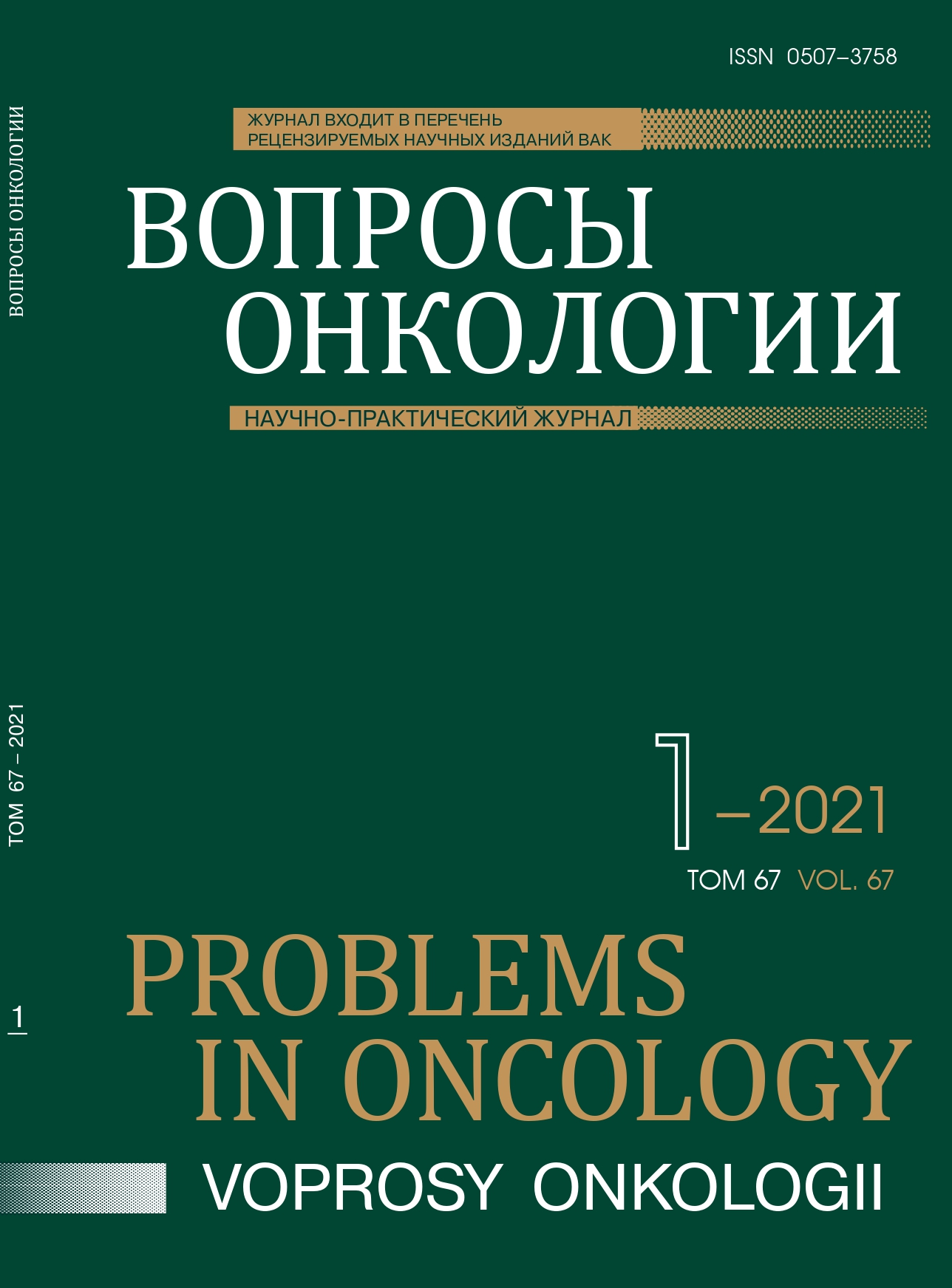Abstract
Introduction. The oncosuppressor protein VHL plays a decisive or at least important role in the mechanisms of tumor progression. The development of malignant neoplasms of the thyroid gland is associated with the activation of transcriptional and growth factors. However, the role of the VHL gene in the mechanisms of the development of thyroid cancer has hardly been studied.
The study aimed to study the clinical and morphological features, expression of transcription, growth factors, and components of the AKT / m-TOR signaling pathway in patients with papillary thyroid cancer depending on the level of expression of the VHL gene.
Material and methods. The study included 46 patients with tumor pathology of the thyroid gland: 20 patients with benign thyroid tumors and 26 patients with papillary thyroid cancer T1-4N0-2M0. The expression of parameters was determined by PCR in real-time. Mutation BRAF-V600E was determined in allele-specific PCR in real-time.
Results and their discussion. The mRNA level of the VHL gene remained virtually unchanged in the tissue of papillary cancer and benign thyroid tumors. It depended on the prevalence of the disease, the defeat of regional lymph nodes, and the BRAF-V600E status. In the presence of the BRAF-V600E mutation, VHL expression increased 615 times in patients with a mutation compared with patients without this somatic mutation. It was revealed that the expression of NF-κB p65, NF-κB p50, HIF-1, HIF-2, growth factors VEGF and CAIX in patients in the group with a VHL level> 1.0 RU increased compared with patients with a VHL level <1.0 RU. A decrease in PDK, c-RAF, mTOR, 70s 6 kinase, PTEN mRNA levels were also recorded in patients with increased levels of VHL expression compared with patients with VHL expression <1.0 RU.
Conclusion. That the association of the VHL expression with tumor progression in papillary thyroid cancer and the mutant protein bRAF presence was found. Also, associations between the VHL expression and the level of mRNA of transcription and growth factors are noted.
References
Li D.D., Zhang Y.F., Xu H.X. et al. The role of BRAF in the pathogenesis of thyroid carcinoma. Front Biosci (Landmark Ed). 2015;20:1068-1078.
Koperek O., Bergner O., Pichlhöfer B. et al. Expression of hypoxia-associated proteins in sporadic medullary thyroid cancer is associated with desmoplastic stroma reaction and lymph node metastasis and may indicate somatic mutations in the VHL gene. J Pathol. 2011;225(1):63-72. doi:10.1002/path.2926.
Todorović L., Stanojević B., Mandušić V. et al. Expression of VHL tumor suppressor mRNA and miR-92a in papillary thyroid carcinoma and their correlation with clinical and pathological parameters. Med Oncol. 2018;35(2):17. doi:10.1007/s12032-017-1066-3.
Stanojevic B., Saenko V., Todorovic L. et al. Low VHL mRNA expression is associated with more aggressive tumor features of papillary thyroid carcinoma. PLoS One. 2014;9(12):e114511. doi:10.1371/journal.pone.0114511.
Baldini E., Tuccilli C., Arlot-Bonnemains Y. et al. Deregulated expression of VHL mRNA variants in papillary thyroid cancer. Mol Cell Endocrinol. 2017;443:121-127. doi:10.1016/j.mce.2017.01.019.
Rossi E.D., Martini M., Bizzarro T. et al. Uncommon BRAF mutations in the follicular variant of thyroid papillary carcinoma: New insights. Cancer Cytopathol. 2015;123(10):593-602. doi:10.1002/cncy.21586.
Спирина Л.В., Чижевская С.Ю., Кондакова И.В. Экспрессия транскрипционных, ростовых факторов и компонентов AKT/m-TOR сигнального пути в ткани папиллярного рака щитовидной железы. Проблемы эндокринологии. 2018; 64(4): 208-215. doi: 10.14341/probl9310 [Spirina L.V., Chigevskaya S.Yu., Kondakova I.V. Expression of transcription, growth factors and components of AKT/m-TOR signaling pathway in papillary thyroid cancers. Problems of Endocrinology. 2018;64(4):208-215. doi: 10.14341/probl9310 (in Russ.)].
Liu Y.M., Ying S.P., Huang Y.R. et al. Expression of HIF-1α and HIF-2α correlates to biological and clinical significance in papillary thyroid carcinoma. World J Surg Oncol. 2016;14(1):30. doi:10.1186/s12957-016-0785-9.
Zerilli M., Zito G., Martorana A. et al. BRAF(V600E) mutation influences hypoxia-inducible factor-1alpha expression levels in papillary thyroid cancer. Mod Pathol. 2010;23(8):1052-1060. doi:10.1038/modpathol.2010.86.
Спирина Л.В., Чижевская С.Ю., Кондакова И.В. и др. Связь мутации BRAF-V600E с экспрессией транскрипционных, ростовых факторов, компонентов АКТ/m-TOR сигнального пути в ткани папиллярного рака щитовидной железы. Вопросы онкологии. 2019;65(4): 608-613 [Spirina L.V.,, Chigevskaya S.Yu., Kondakova I.V. et al. The relationship of the BRAF-V600E mutation with the expression of transcriptional, growth factors, components of the AKT / m-TOR signaling pathway in the tissue of papillary thyroid cancer. Problems in Oncology. 2019;65(4): 608-613 (in Russ.)].
Le F., Zhang J.Y., Liu W. et al. The levels of NF-κB p50 and NF-κB p65 play a role in thyroid carcinoma malignancy in vivo. J Int Med Res. 2018;46(10):4092-4099. doi:10.1177/0300060518785846.
Park A., Lee Y., Kim M.S. et al. Prostaglandin E2 Secreted by Thyroid Cancer Cells Contributes to ].Immune Escape Through the Suppression of Natural Killer (NK) Cell Cytotoxicity and NK Cell Differentiation. Front Immunol. 2018;9:1859. doi:10.3389/fimmu.2018.01859.
Azoitei N., Becher A., Steinestel K. et al. PKM2 promotes tumor angiogenesis by regulating HIF-1α through NF-κB activation. Mol Cancer. 2016;15:3. doi:10.1186/s12943-015-0490-2.
Sun X., Feinberg M.W. NF-κB and hypoxia: a double-edged sword in atherosclerosis. Am J Pathol. 2012;181(5):1513-1517. doi:10.1016/j.ajpath.2012.09.001.
Labrousse-Arias D., Martínez-Alonso E., Corral-Escariz M. et al. VHL promotes immune response against renal cell carcinoma via NF-κB-dependent regulation of VCAM-1. J Cell Biol. 2017;216(3):835-847. doi:10.1083/jcb.201608024.
Спирина Л.В., Слонимская Е.М., Юрмазов З.А. и др. Роль ядерного фактора NF-KB и белка фон Хиппель-Линдау в формировании молекулярного портрета опухоли почки. Молекулярная медицина. 2019; 17(3):15-19. doi: 10.29296/24999490-2019-03-03 [Spirina L.V., Slonimskaya E.M., Yurmazov Z.A. et al. The role of TNF-κB and Hippel-Lindau protein in the creation of a molecular portrait of kidney cancers. Molekulyarnaya meditsina. 2019; 17 (3): 15-19. https://doi.org/10.29296/24999490-2019-03-03(in Russ.)].

This work is licensed under a Creative Commons Attribution-NonCommercial-NoDerivatives 4.0 International License.
© АННМО «Вопросы онкологии», Copyright (c) 2021
